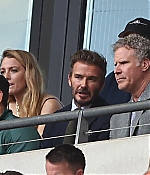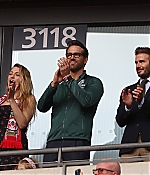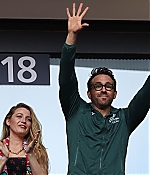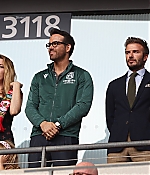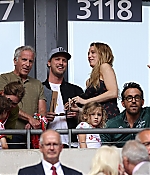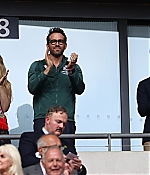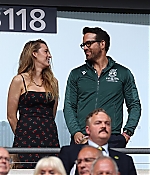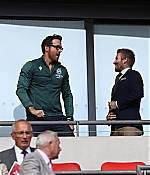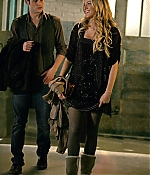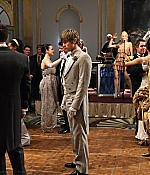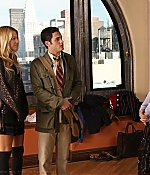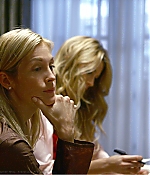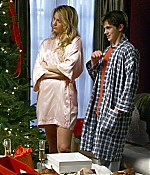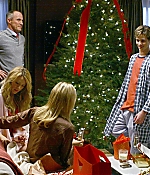I can’t quite recall the disquieting moment when I realized that they were, in fact, all around me. I knew that Cameron Diaz broke her nose doing it and was unsurprised to discover that Stefano Pilati is very, very good at it. I was amazed to hear that my friend Holly Peterson travels to the ends of the Earth in pursuit of it and that Cynthia Rowley fashions clothing expressly for it. I knew that Damien Hirst’s partner, Maia, is gaga for it but that he’d rather just watch, and I was frankly dumbfounded that both Barneys’ gnomish Simon Doonan and Vanity Fair‘s Falstaffian Graydon Carter each had a go—and with the same happy band of practitioners, no less.
Instead of a Mason’s handshake or the furtive double glance of pre-Stonewall Temperamentals, an evangelical glint in the eye helped me recognize these cultists. Their faces would take on a beatific cast when I raised the subject, and in reverent tones they evoked otherworldly pleasures beyond the ken of ordinary mortals. And now I was about to be abducted into this bitchin’ netherworld of tubes, lips, and barrels.
In short, Anna was sending me to surf camp.
Actually, as this is Vogue and we don’t do things in half measures, Anna was sending me, Mario Testino, his vast supporting cast of South American godlets, and Fashion Director Tonne Goodman to photograph Best Dressed icon Blake Lively with surf deity Rob Machado and his posse. The plan was that I would go a day or two early to balmy La Jolla, California, to get a head start under the expert tutelage of Jonathan Paskowitz, who has been surfing since he was three. “I love turning people on to surfing,” Jon told me, “to look through that window and see what’s on the other side. It’s as if I could teach you how to fly.” His was a challenge more improbable than he might have imagined: I never venture farther into the sea than where I can still touch bottom, and make it a general rule not to get my hair wet in pool or ocean, having developed a genteel stroke all my own to achieve this remarkable feat.
The adventure begins in the Vogue offices when I am bidden to look at the fittings shots of Blake Lively, which reveal a body sublimely toned for her upcoming role as Carol Ferris (a.k.a. ultravillain Star Sapphire) in Martin Campbell’s Green Lantern, based on the DC Comics superhero introduced in 1940. “All I want is to be a hero to my nephews and nieces,” Lively says, laughing. “I’m going to be the coolest aunt ever.”
Lively has been rehearsing with a stunt coordinator who works on the Bond movies and with gymnastic acrobats from Cirque du Soleil. “Our director likes it real—the fights close and dirty,” she explains, and for added veracity aerial stunts are being filmed in the rig created for The Matrix. “I’m 40 feet in the air, spiraling around. That’s the best workout you can ever do because it’s all core,” she tells me. “You do that for ten minutes and you should see your body the next day! It’s so exhilarating, so thrilling—and nauseating,” she adds, all of which promises to stand her in good stead for the surf experience to come.
“I think we need to see you in your suit,” Goodman tells me in a firm maternal tone that brooks no argument. I duly repair to the fashion closet and spend a good half hour attempting to prize myself into an O’Neill bodysuit, gloves, footwear with bifurcations for the big toes, and balaclava. (Lively will later compare this routine to “the process it takes to get into couture!”) Goodman appraises the effect with a professional eye. “Of course you have to pee in your wet suit,” she declares with startling matter-of-factness. “It will keep you warm; they all do it.”
The following morning I find myself half a world away in this same fetching ensemble in a parking lot adjacent to Cardiff State Beach, near Encinitas, the irrepressible Paskowitz at my side. Jonathan is one of the famous Paskowitz clan, “surf’s first family.” His father, Dorian “Doc” Paskowitz, disillusioned with contemporary medical practices that focused on palliative care rather than preventive medicine, opted out of the system in the fifties, married Juliette Emilia Paez, and proceeded to raise and homeschool nine children (“He just wanted to live like an opossum with his kids hanging off him”) in a camper van. He encouraged his boisterous clan to surf practically as they learned to walk, and established perhaps the first ever surf camp (in 1972). “It was a crazy life,” says Jon, who provided nonstop entertainment to his siblings in lieu of a television set. What were mealtimes like? I query. “Have you seen piranhas feed?” he replies.
As I survey the ominous infinity of roiling waters before me, I ask whether we couldn’t start out in a pool with a wave machine. Jon laughs. “You are not going to die, Hamish,” he says (although he later admits to three near-death experiences). “The surf today is tiny—it’s barely breaking. Worst-case scenario, I give you the kiss of life.”
Out in the ocean, a man is miraculously walking on water. Actually he is standing on a board and holding a paddle. Jon’s eyes roll. Surfers and paddleboarders are apparently engaged in an Oklahoma!-esque farmer-and-cowboy turf war.
Astutely realizing that we are not going to learn to surf in three days, Jon and Rob have decided that they will take Blake and me out tandem on long boards so that they will be able to guide and steady us through the waves. This will prove a masterstroke. Jon and I lie flat on our board—he steers from behind while I act as white-water buffer in front—paddling for all we are worth to get through the relentless smacking waves. The water is glacial (Jon vetoes wearing gloves), the paddling unimaginably exhausting. Mr. P. keeps up a riveting monologue with interruptions that become ever rarer, as each time I open my mouth it is sluiced with briny waters. (Jon had sagely warned me not to eat breakfast, though he added, “It’s OK if you throw up—feeds the fishes, it’s the circle of life.”)
Suddenly we are beyond those breaking waves. My ribs bruised and my eyes stinging from the saltwater, I turn to look back at the shore. I can barely see it. We are now in a completely alien environment. Although Jon is a profoundly reassuring presence, this is nevertheless very unnerving. Until it isn’t. Until it is astonishingly serene. The pelicans swoop and dolphins gambol in the far distance. The ocean is like hammered steel, the sky cerulean. The droplets of water on our board are like scatterings of cabochon moonstones. It is hallucinatory. Then suddenly Jon is paddling like a fury, reorienting the board to face the shore. “Paddle! Paddle! Paddle!” he cries, and I do so with all my strength as a wave I hadn’t even noticed churns beneath us, and weirdly, miraculously, we are propelled forward at great speed. “Stand, stand, stand!” he bids as the wave dies a little. I do, he steadies me, and we sail ever onward. “You’re ripping, man!” he says kindly. “This will be part of your skill set,” he tells me later, suavely tapping into my mind-set, “something you’ll be able to take with you and use around the world—Biarritz, San Sebastian, Fiji.”
Rob Machado surfed his first wave at the age of nine. “To catch a wave, to stand up—it was just life-changing,” he remembers. “There was nothing that even came close. I quit playing all other sports—by the time I was eleven, they were toast.” It is indeed difficult to describe the exultant rush of catching a wave and feeling its power carry you relentlessly forward, heart bounding, knees trembling as you attempt to stand and hold your balance in one fell movement. Imagine if you will a child’s delight in a nerve-racking, white-knuckle fairground ride combined with a pleasure altogether more adult. Suffice it to say that as the wave crashes prettily into a broderie anglaise froth and hurls me into the icy waters, I understand why landlocked surfer dudes seem to be in a near perpetual state of postcoital lassitude. “You can see how surfers get a bad rap,” Rob tells me later. “You kind of forget about the rest of the things you’re supposed to be doing.”
After a hearty brunch I can’t wait to get back in the ocean (I even forgo a visit to Louis Kahn’s iconic masterpiece, the Salk Institute, which will stun anyone who knows me). Jon takes me out to San Onofre State Beach, one of California’s first surf beaches. “It’s the secret wonder zone, just riddled with coolness,” he says. It is a transcendently beautiful spot. Here the surf dudes dress retro style (Paskowitz has revived the iconic seventies Lightning Bolt brand) and take to the ocean alongside a convivial group of old-timers who have been hanging here for decades, apparently smoking their way through California’s number-one cash crop. In the water is a little towheaded boy who tells us he is eight—”but I’ve been doing this stuff since I was six,” he says before nonchalantly catching a wave and sailing off to the distant shore.
Day two, Jon takes me out on my own board alongside him. As it is a Saturday, the seascape now resembles a large colony of sea lions, with dozens of surfers in their sleek black suits surreally bobbing on their boards, eyes glued to the horizon. (“Half of the learning process of surfing is learning about the ocean,” Rob tells me later. “Seeing a wave crumbling and understanding where it’s going to break and how it’s going to break.”) “You become a predator,” explains Jon, “to find, hunt, and catch that wave.”
This time the solo paddling nearly kills me, and I am a martyr to the white water, battered and buffeted at every turn. I totter up for nanoseconds before the waters claim me again and again, and I spend most of my time “pearling” (diving headfirst to the ocean bed). “Isn’t surfing a gas, Hamish?” asks Jon. “It’s soul candy.”
But enough about me. Testino has landed. Lively has just flown in from New Orleans (where Green Lantern is filming), and Machado—ice-blue eyes shaded by Dragon sunglasses with giant lenses that transform with the light from Tequila Sunrise to The Blue Lagoon—arrives in an ultramarine VW van (“the original surf vehicle”). Although Blake is as sun-kissed and gorgeous as a seventies Bond Girl, it is local hero Machado who gets the attention around here. Passing cars toot their horns and kids high-five him. He must be something of a stranger; Rob spends a few months in Hawaii every year and by midsummer will have traveled to Panama, Brazil, Bali, Japan, Nicaragua, Italy, Tahiti, and France to surf and promote his movie The Drifter (directed by his friend Taylor Steele), a semidocumentary of a travel odyssey through Indonesia.
At our Japanese dinner for the team that night, Blake is a picture of urban chic in a white blazer, skinny black jeans and tee, lipstick-red patent heels, and her hair twisted into her trademark chignon knot. But there are surf movies playing on twin screens, and as a result it is difficult to sustain conversation; they are hypnotic. Now that I know how difficult it is to even stand up on a board, seeing these deities slice through the breaking curve of 50-foot waves is breathtaking.
Blake admits that she has surfed once before—at Manhattan Beach when she was thirteen—but the memory is a painful one. She had bought herself a pink-and-purple thrift-store bodysuit à la Pamela Anderson in Baywatch and braved the waters at five in the morning with her brother-in-law, “who had too much faith in me.” “I didn’t get on the board and paddle out,” she remembers. “I carried the board out, sideways to the surf. I was trying to crawl on the board when I was caught by a wave. I just went spinning and cracked my nose on the hard-packed sand. I relaxed for a second, went to the top, and then the board hit me and I ended up with a bloody nose.” Scuba diving in the Maldives last year finally convinced her that the ocean might be a more welcoming place. “It was the most peaceful and tranquil thing,” she says. “I fell in love with it.”
At midnight, Blake and her beau, Penn Badgely, knock on my hotel door, bearing a tray full of sublime doughnuts from the legendary local V.G. Donut & Bakery. Blake had managed to charm the baker into opening up shop although he had long since hung up the CLOSED sign. This characteristically sweet gesture (she bought beignets for the entire New Orleans crew the week before to sustain them on a late-night shoot) is a comfort for many reasons; channel surfing that evening, I had tuned to a documentary about great white sharks and the various scarifications they had left as calling cards on hapless surfers around the world.
The following morning, Blake (who spent much of her childhood in suburban Los Angeles) is the quintessential laid-back, barefoot California girl. “I haven’t lived in California for so long,” she says sheepishly, “but my New York guise is gone. Ostrich flats don’t really work on the beach!” New Orleans has already lulled her into its gentler pace. “I’m used to that sweet, syrupy Southern mentality,” she says. “There is so much heart. I love, love, love New York, but it’s nice sometimes to have not so much to do—there’s time to walk through the park and to cook.” Between filming she has been shopping for the antiques that decorate her trailer, where she watches movies like A Streetcar Named Desire and listens to bluegrass and forties big-band music.
Once she is out in the waves with Rob, Blake gets the hang remarkably quickly, standing serenely for long stretches. “You’ve got the Rolls-Royce engine,” Jon tells Blake playfully as she and Rob deftly skim by. “This is the Ford Fairlane.” At one point I look over, and to my astonishment Blake is coolly lying with her back on the board, looking up at Rob as they crest a wave. “I want to watch you watch the wave, to see what you are experiencing,” she tells him. (“My goal was to keep her hair dry!” he tells me later. “I failed, but she never actually fell. We rode every wave to the end.”)
As Jon and I chat with our fellow sea lions (“It’s a schmoozy-woozy kind of world,” says Jon, “You chatter, you cavort, you give away stickers”), I notice that the Lively-Machado superteam has disappeared into the glassy horizon—in pursuit, it turns out, of dolphins. “I’ve never been that close to them before—outside of SeaWorld!” says Blake. “We went out trying to speak dolphin to them—apparently they like noises.” “They can hear your heartbeat,” adds Jon.
Back on shore, Blake is exultant. “It’s so much fun—it’s easy with Rob,” she tells me. “He’s very calm and peaceful, a really nice teacher,” she adds, “but he’s crazy in the water. For three days [during the Testino shoot] he’d been so calm…and then when we were out in the ocean he said, ‘OK, let’s party!’ The passion, the fire—you can see how it ignites him.”
Our reveries are interrupted by the sudden vision of someone who looks remarkably like Penn Badgely insouciantly riding a wave, perfectly upright on his board. As the preternaturally steady figure draws ever closer, we realize that it is indeed and infuriatingly Badgely, who has been on a surfboard once before in his life but never managed to stand up. And here he is, bold as brass, riding the wave.
“So rad, dude!” chorus his fellow surfers. I cling to the thought that he is half my age and a stocky powerhouse of muscle and sinew.
“Wow!” says Blake. “I’m so jealous-slash-inspired.”
Back in the water the mortification continues when I am accidentally hit by someone else’s board and manage to connect unhappily with my own and chip a tooth (although in the interest of full disclosure, I think a fragment of shell in my lunchtime lobster salad may have helped it on its way). I have seen the endgame, and now it doesn’t matter anymore. “Being in the waves, beautiful things happen,” says Jon. He has me hooked. But then he had me at “Yo.”
With legendary surf gurus to guide them, Blake Lively and Hamish Bowles learn how to catch a wave.
“The Swell Life” has been edited for Vogue.com; the complete story appears in the June 2010 issue of Vogue.
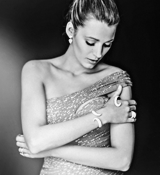 Welcome to Blake Lively Source, your #1 fansite and guide about the actress
Blake Lively. We work to provide you with the latest news, photos,
videos and more!
We hope you will enjoy our site and we encourage you to visit us again to get the latest updates on
Blake.
Welcome to Blake Lively Source, your #1 fansite and guide about the actress
Blake Lively. We work to provide you with the latest news, photos,
videos and more!
We hope you will enjoy our site and we encourage you to visit us again to get the latest updates on
Blake.
